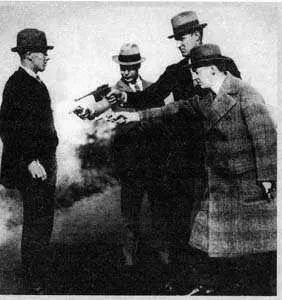In the end, enough of the Comet wreckage was recovered to verify Sir Harold’s theories. A structural failure had indeed caused both planes to break apart in midair. Hats off to Sir Harold and the guinea pigs of Farnborough.
Dennis and I are eating an early lunch at an Italian restaurant near the beach. We are the only customers, and it’s way too quiet for the conversation going on at our table. Whenever the waiter appears to refill our water glasses, I pause, as though we were discussing something top secret or desperately personal. Shanahan seems not to care. The waiter will be grinding pepper on my salad for what seems like a week, and Dennis is going, “…used a scallop trawler to recover some of the smaller remains…”
I ask Dennis how, knowing what he knows and seeing what he sees, he ever manages to board a plane. He points out that most crashing airplanes don’t hit the ground from thirty thousand feet. The vast majority crash on takeoff or landing, either on or near the ground.
Shanahan says 80 to 85 percent of plane crashes are potentially survivable.
The key word here is “potentially.” Meaning that if everything goes the way it went in the FAA-required cabin evacuation simulation, you’ll survive. Federal regulations require airplane manufacturers to be able to evacuate all passengers through half of a plane’s emergency exits within ninety seconds. Alas, in reality, evacuations rarely happen the way they do in simulations. “If you look at survivable crashes, it’s rare that even half the emergency exits open,” says Shanahan. “Plus, there’s a lot of panic and confusion.” Shanahan cites the example of a Delta crash in Dallas. “It should have been very survivable. There were very few traumatic injuries. But a lot of people were killed by the fire. They found them stacked up at the emergency exits. Couldn’t get them open.” Fire is the number one killer in airplane mishaps. It doesn’t take much of an impact to explode a fuel tank and set a plane on fire. Passengers die from inhaling searing-hot air and from toxic fumes released by burning upholstery or insulation. They die because their legs are broken from slamming into the seat in front of them and they can’t crawl to the exits.
They die because passengers don’t exit flaming planes in an orderly manner; they stampede and elbow and trample. [20] Here is the secret to surviving one of these crashes: Be male. In a 1970 Civil Aeromedical Institute study of three crashes involving emergency evacuations, the most prominent factor influencing survival was gender (followed closely by proximity to exit). Adult males were by far the most likely to get out alive. Why? Presumably because they pushed everyone else out of the way.
Could airlines do a better job of making their planes fire-safe? You bet they could. They could install more emergency exits, but they won’t, because that means taking out seats and losing revenue. They could install sprinkler systems or build crash-worthy fuel systems of the type used on military helicopters. But they won’t, because both these options would add too much weight. More weight means higher fuel costs.
Who decides when it’s okay to sacrifice human lives to save money?
Ostensibly, the Federal Aviation Administration. The problem is that most airline safety improvements are assessed from a cost-benefit viewpoint. To quantify the “benefit” side of the equation, a dollar amount is assigned to each saved human life. As calculated by the Urban Institute in 1991, you are worth $2.7 million. “That’s the economic value of the cost of somebody dying and the effects it has on society,” said Van Goudy, the FAA man I spoke with. While this is considerably more than the resale value of the raw materials, the figure in the benefits column is rarely large enough to surpass the airlines’ projected costs. Goudy used the example of shoulder harnesses, which I had asked him about. “The agency would say, ‘All right, if you’re going to save fifteen lives over the next twenty years by putting in shoulder straps, that’s fifteen times two million dollars; that’s thirty million.’ The industry comes back and says, ‘It’s gonna cost us six hundred and sixty-nine million to put the things in.’” So long, shoulder straps.
Why doesn’t the FAA then come back and say, “Tough tiddlywinks. You’re putting them in anyway”? For the same reason it took fifteen years for the government to begin requiring air bags in cars. The regulatory agencies have no teeth. “If the FAA wants to promulgate a regulation, they have to provide the industry with a cost-benefit analysis and send it out for comment,” says Shanahan. “If the industry doesn’t like what they see, they go to their congressmen. If you’re Boeing, you have a tremendous influence in Congress.” [21] This is no doubt why planes today are not equipped with air bags. Believe it or not, someone actually designed an airplane air-bag system, called the Airstop Restraint System, which combined underfoot, underseat, and chest air bags. The FAA even tested the system on dummies on a DC-7 that it crashed into a hill outside of Phoenix, Arizona, in 1964. While a control dummy in a lap belt fastened low and tight about it jackknifed violently and lost its head, the Airstop-protected dummy fared just fine. The designers were inspired by stories of World War II fighter pilots who would inflate their life vests just before a crash.
To the FAA’s credit, the agency recently approved a new “inerting” system that pumps nitrogen-enriched air into fuel tanks, reducing the levels of highly flammable oxygen and the likelihood of an explosion such as the one that brought down Flight 800.
I ask Dennis whether he has any advice for the people who’ll read this book and never again board a plane without wondering if they’re going to wind up in a heap of bodies at the emergency exit door. He says it’s mostly common sense. Sit near an emergency exit. Get down low, below the heat and smoke. Hold your breath as long as you can, so you don’t cook your lungs and inhale poisonous fumes. Shanahan prefers window seats because people seated on the aisle are more likely to get beaned with the suitcases that can come crashing through the overhead bin doors in even a fairly mild impact.
As we wait for the bill, I ask Shanahan the question he gets asked at every cocktail party he’s been to in the past twenty years: Are your chances of surviving a crash better near the front of the plane or the back?
“That depends,” he says patiently, “on what kind of crash it’s going to be.”
I rephrase the question. Given his choice of anywhere on the plane, where does he prefer to sit?
“First class.”
6. THE CADAVER WHO JOINED THE ARMY
The Sticky Ethics of Bullets and Bombs

For three days in January of 1893 and again for four days in March, Captain Louis La Garde of the U.S. Army Medical Corps took up arms against a group of extraordinary foes. It was an unprecedented military undertaking, and one for which he would forever after be remembered.
Though La Garde served as a surgeon, he was no stranger to armed combat. In the Powder River Expedition of 1876, he had been decorated for gallantry in confronting tribes of hostile Sioux. La Garde had led the charge against Chief Dull Knife, whose name, we can only assume, was no reflection on his intellectual and military acumen or the quality and upkeep of his armaments.
La Garde received his strange and fateful orders in July of 1892. He would be receiving, the letter said, a new, experimental .30-caliber Springfield rifle. He was to take this rifle, along with his standard-issue .45-caliber Springfield, and report to Frankford Arsenal, Pennsylvania, the following winter. Taking shape in the rifles’ sights would be men, a series of them, naked and unarmed. That they were naked and unarmed was the less distinctive thing about them. More distinctive was that they were already dead. They had died of natural causes and had been collected—from where is not revealed—as subjects in an Army Ordnance Department experiment. They were to be suspended from a tackle in the ceiling of the firing range, shot at in a dozen places and with a dozen different charges (to simulate different distances), and autopsied. La Garde’s mission was to compare the physiological effects of the two different weapons upon the human body’s bones and innards.
Читать дальше













